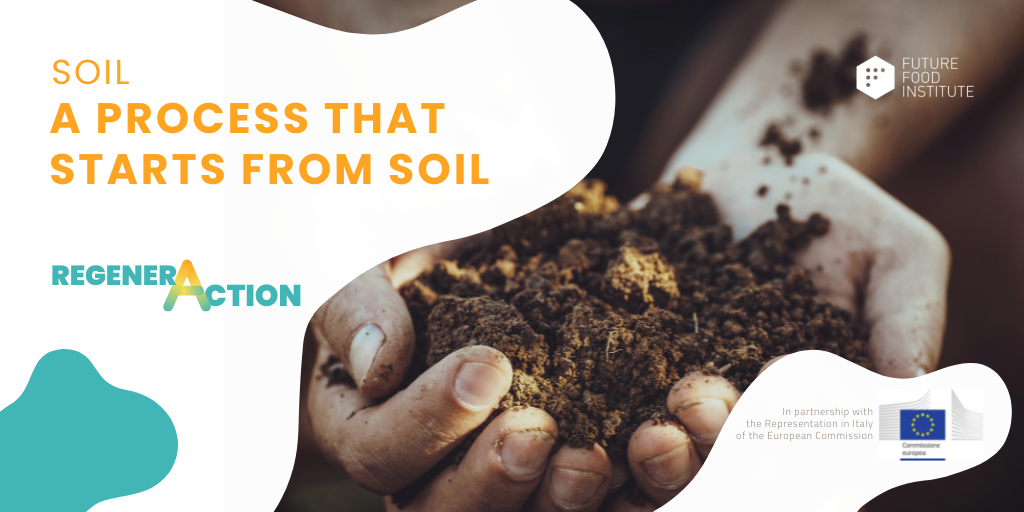Soil: A Challenge that starts from the ground
📢 How can we safeguard food security for all, while ensuring that our soils are able to sustain life for years to come? The Green Revolution and the technological advances in agriculture it brought have freed most of us from the burden of cultivating land and growing food. But has this all come at a cost? Aren’t we taking anything out of the equation?
Why it is important: Healthy soils, healthy lives
❗ We tend to think about soil as a lifeless medium in which plants diffuse their roots to absorb the nutrients they need for their growth. Occasionally, some insects might crawl, looking for food. However, roots, bacteria, fungi, nematodes, and other living beings that populate the underworld create a long and complex food chain. For millions of years, well before the invention of the World Wide Web, plants perfectly exemplified the beauty, diversity, and complexity of networks through the constant sharing of information via fungal mycelia – the real “deep web” hidden underneath our feet.
It is thanks to this complex web of life that healthy soils provide a lot more benefits in terms of ecosystem services: they prevent floods, filter water, provide housing for micro and macro-biodiversity, recycle nutrients, store water and carbon locking it below the ground to prevent it from entering the atmosphere and warming the planet. Without healthy soils, there can be no healthy society. Our well-being depends on this limited resource. The way by which soil forms – a process called pedogenesis – can take hundreds or even thousands of years to occur. Yet, land-use change, unsustainable agricultural practices, and overbuilding can sweep away the soil along with the life forms and benefits it sustains in just a few seconds.
It is estimated that organic soil drainage across all land categories in Europe alone emits around 5% of total EU greenhouse gas emissions. Every year, agricultural land in Europe is losing around 7.4 million tonnes of carbon – a cost that heavily reverberates into economies. The “price” of soil degradation and improper management today exceeds €50 billion per year. These figures are hard to conceive but clearly confirm how dependent soil fertility, soil health, and ecosystem services are on carbon – the real coin of life.
The solution is in front of us, or better, below us. Carbon sequestration in forests and agricultural land is a cost-effective emission mitigation method with significant potential to sequester between 11 to 38 MtCO2eq annually in Europe. If we used a holistic and integrated approach to manage land and soil health, we would be able to effectively mitigate climate change and reduce the risks associated with it, ensuring the production of safe and nutrient-dense food and creating a healthier – and more peaceful – world.
EU Strategy: Connecting Soils, Biodiversity, Farms, and Forks
🇪🇺 With the Soil Strategy launched in November 2021, the EU has taken a pledge and set clear goals for a roadmap to achieve good soil health by 2050. How does it do that? By limiting the drainage of wetlands and organic soils, restoring managed and drained peatlands, developing a long-term vision for sustainable carbon cycles, limiting land take and soil sealing with a circular use of land, closing the nutrient and carbon circle, and preventing desertification and soil pollution.
The Strategy is built upon the European Green Deal, the long-term vision and call to action of the European Union to make Europe the first carbon-neutral continent before 2050, and is strictly entangled with the EU Biodiversity Strategy and the Farm to Fork Strategy. According to these two strategies, soils are the core element at the basis of the agri-food system and need to be tackled through the reduction of chemical and hazardous pesticides, better protection of soil quality, and a wider network of protected areas on land and at sea to ensure the perfect functioning of ecosystem services.
Despite the many disappointments that the new Common Agricultural Policy has created, being in some cases “too conservative,” there are many implementations that support regenerative agriculture and carbon farming. The distance between policymakers and producers needs to be reduced, as the low implementation rate of eco-schemes within the previous Italian CAP attests, but some steps forward have been made into a holistic vision for the European food system and the process toward a productive Common Food Policy.
Seeds of Change: Regenerating Agriculture and its guardians
🌱 Future Food Institute is supporting the creation of momentum to promote regenerative soil and land management, in coherence with the framework of Integral Ecology. Taking part in the first Climate Farming Congress organized by Climate Farmers was the first step in a life-long journey that will drive the regenerative transformation of our food system.
To do so, we need brave pioneers who can prove to us it is possible to produce food and be stewards of nature at the same time: the EU Mission ‘A Soil Deal for Europe’ is to establish 100 living labs and lighthouses to lead the transition towards healthy soils by 2030.
To assist these stewards in making better decisions, testing and supporting technological programs, such as the EIT Food Test Farms Programme, of which FFI is a proud partner, are essential. Beyond that, we need experts and trainers who can teach us how to face the transition and re-instill the value of care in the whole food supply chain. This is how we are planning to act for our next Future Food – Rareche Academy, by empowering fruitful conversations like the ones Future Food Institute facilitated for the Mediterranean Diet anniversary.
We need to create more diverse and decentralized systems. The Ukrainian crisis and the rising food prices have once again revealed that our food system heavily depends on fertilizers and other inputs, of which Russia is a top exporter. By contributing to soil health, agroecology, and sustainable agriculture have the power to escape from external input dependence, provide safe and nutritious food, and ensure ecosystem services are delivered to communities.
Above all, we need a Soil Health Law, which the European Commission has planned to present by 2023, and that has to be harmonious and coherent with the One Health Approach. To reach this goal, everyone has to take part in the transition. Because soil health means planet health and planet health means a safe house for us all.
We will talk about this and much more in the first panel of RegenerAction, entitled “Farm To Fork – Regeneration Starts From soil” and in many more panels during the EU Agrifood Week.
“The solution is just under our feet.” – Kiss the Ground
👉 Follow us on Twitter!
#RegenerAction2022 #EUAgrifoodWeek2022

